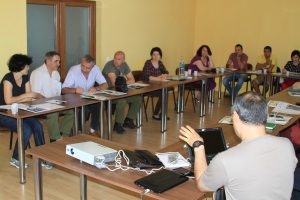Invasive species management
A campaign for removing the invasive tree species (Alianthus altissima, Amorpha fruticosa, Robinia pseudoaccacia and Rhus hirta) was implemented, including identification of the areas where the species developed, marking, cutting and transporting them to depositing areas. Moreover, leaves and seeds were burned in order to reduce trees dispersion. Thus, 55 hectares of land where cleaned of invasive species (Ailanthus altissima, Amorpha fruticosa).
 4 sessions of excessive aquatic weeds and invasive species were performed in the wetlands from Calinovăț, Divici, Pojejena, Șușca, Moldova Nouă, Liborajdea. They have resulted in eliminating the aquatic vegetation from more than 115 hectares of water surface.
4 sessions of excessive aquatic weeds and invasive species were performed in the wetlands from Calinovăț, Divici, Pojejena, Șușca, Moldova Nouă, Liborajdea. They have resulted in eliminating the aquatic vegetation from more than 115 hectares of water surface.
Two demonstrative sessions for biomass reduction were also performed along the Danube for Natura 2000 sites managers. They were trained so they can transfer this removal technique in the the areas they are working on.
Excessive plants harvesting is the only certified method ensuring reduction of species that compete the protected species without introducing chemical compounds (with herbicidal action) in the environment, dredging or draining the wetlands. The results of this action ensured favourable wintering and feeding habitats for more than 500 pygmy cormorants and habitats for other 12 protected species (e.g. Aythya nyroca).
The components of the aquatic invasive species early warning system (IAS – Invasive Aquatic Species) are:
 IAS assessment – Species, phenology, invasion magnitude and paths;
IAS assessment – Species, phenology, invasion magnitude and paths;- Training managers of protected areas, fishing and hunting areas, training (47 people trained in two training sessions);
- Toolkit for identifying the invasive species – format pdf, external link;
- Web page for species reporting – available here.
